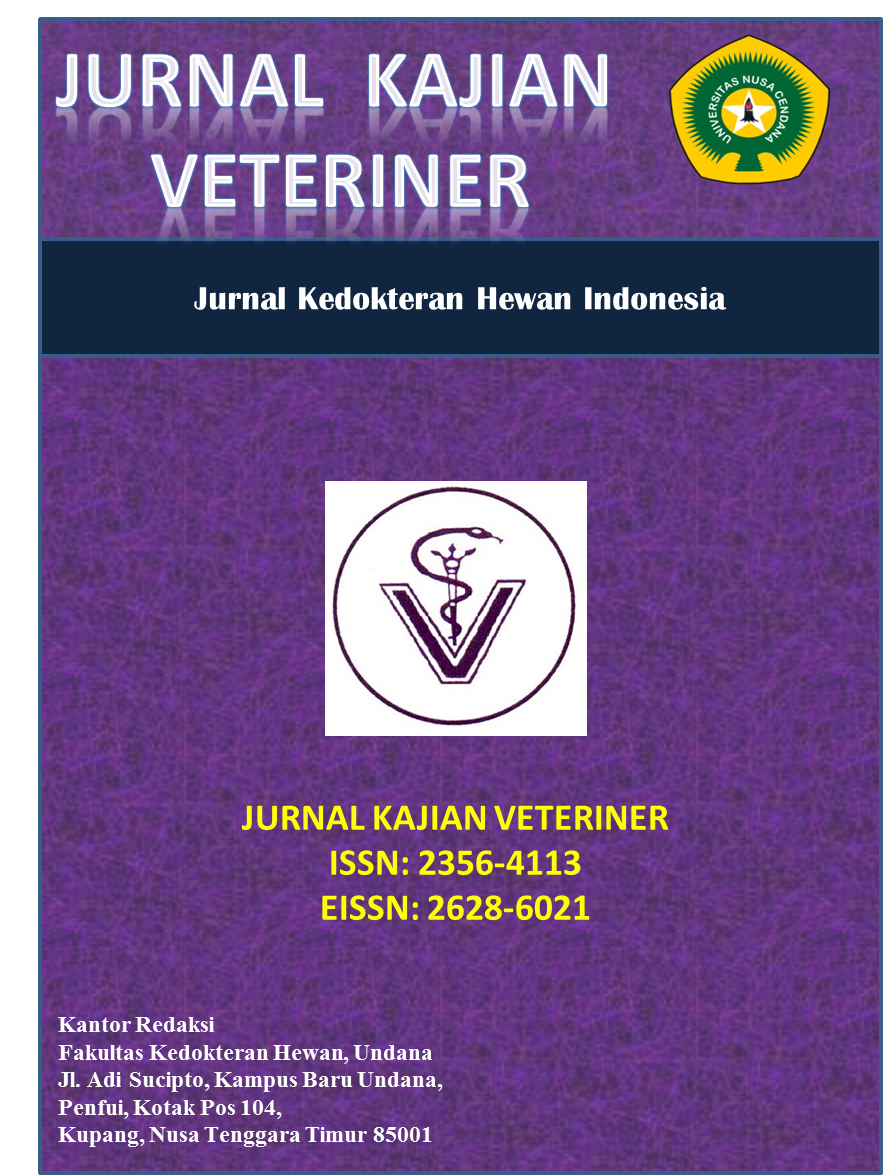The Penanganan Penyakit Hernia Umbilikalis pada Kucing di Klinik Hewan DRD Veterinary Animal Care Kota Surabaya
Treatment of Umbilical Hernia in Cat at DRD Veterinary Clinic Animal Care Surabaya City
Abstract
Mammal animal as companion animal is cat. The disease that can attack cat can be infectious and non-infectious. Infectious disease can be caused by bacteria, viruses, and fungi, while one of non-infectious diseases in cat is hernia. Hernia is a form of abnormal protrusion that occurs in organ from its normal location through a hole into a sac lined by 3 layers including the peritonium, tunika flava dan skin. The purpose of this activity is to find out the procedure, clinical symptoms, examination, and treatment of cats with hernia umbilicalis in inpatients at DRD Veterinary Clinic Surabaya City. Hernia can occur caused by congenital or trauma. The diagnostic methods of umbilical hernia taken from signalement, anamneses, physical examination with clinical sign that seen from hernia is abdominal swelling in umbilicus area, and then do the Xray examination with lateral view to see hernias ring and content of the hernia that appear radiolucent. Treatment of umbilical hernia case is surgery. Post surgery treatment was hospitalizes for 10 days with antibiotic oxytetracycline (Vet-Oxy LA®) to prevent the secondary infection and cleaning the wounds with Die Da Yao Jing® twice a day with sterile bandage dressing.
Downloads
References
Apritya, D., Widyawati, R., Aritonang, E. A., Djawa, M. N. L., Saputra, F., & Dayanti, I. A. A. (2020). Bedah Reposisi Hernia Perineal pada Kucing Betina. J Med Vet, 3, 277-82.
Febriani, A. F. (2017). Studi Kasus Penanganan Hernia Umbilikalis Pada Kucing Di Rumah Sakit Hewan Provinsi Jawa Barat. [Skripsi]. Fakultas Kedokteran. Universitas Hasanudin.
Fossum, T.W. (2019). Small Animal Surgery 5th Edition. Elsevier: St. Louis, Missouri.
Lee, T. Y. & Lam, T. H. (2000). Contact Dermatitis due to Traditional Chinese Medicine in Hong Kong. Hong Kong dermatology & Venereology bulletin.
Papich, M. G. (2015). Veterinary Drugs. 5th Edition. Elsevier. 291-689.
Pau, P. F. L., Simarmata, Y. T., & Restiati, N. M. (2021). Laporan Kasus: Penanganan Obstruksi Usus pada Anjing di Bali Veterinary Clinic. Jurnal Kajian Veteriner, 9(1), 50-61.
Apritya, D., Rahman, M. N., Latif, A. C., Yuyun, M. E., Nahak, I. M. P., Mahpuz, F. A., ... & Murtado, M. (2021). Hernia Traumatik Dinding Abdomen Pada Kucing Ras Mix. VITEK: Bidang Kedokteran Hewan, 11(2), 58-63.
Sardjana, I.K.W. dan Kusumawati, D. (2020). Anastesi Veteriner Jilid 1. Cetakan kelima. Gadjah Mada University Press. Yogyakarta.
Septhayuda, I. E., Dada, I. K. A. dan Pemayun, I. G. A. G. P. (2021). Laporan Kasus: Penanganan Hernia Umbilikalis pada Kucing Persilangan Persia Betina. Indonesia Medicus Veterinus. 10(1): 146-157.
Solfaine, Rondius. (2019). Patologi Veteriner: Patogenesis Dasar Penyakit Hewan. Proyeksi Indonesia. Daerah Istimewa Yogyakarta. 46.
Sukma, N. K. A. M., Sudisma I. G. N. dan Putra, I. G. A. G. (2019). Laporan Kasus: Penanganan Hernia Umbilikalis pada Anjing Jantan Keturunan Shih-Tzu Umur Satu Tahun. Indonesia Medicus Veterinus. 8(5): 695-705.
Gebremedhin, Y., Negash, G., & Fantay, H. (2018). Clinical evaluation of anaesthetic combinations of xylazine-ketamine, diazepam-ketamine and acepromazine-ketamine in dogs of local breed in Mekelle, Ethiopia. SOJ Veterinary Science, 4(2), 1-9.
Copyright (c) 2023 JURNAL KAJIAN VETERINER

This work is licensed under a Creative Commons Attribution-NonCommercial-NoDerivatives 4.0 International License.

 Indra Rahmawati(1)
Indra Rahmawati(1)








.png)


